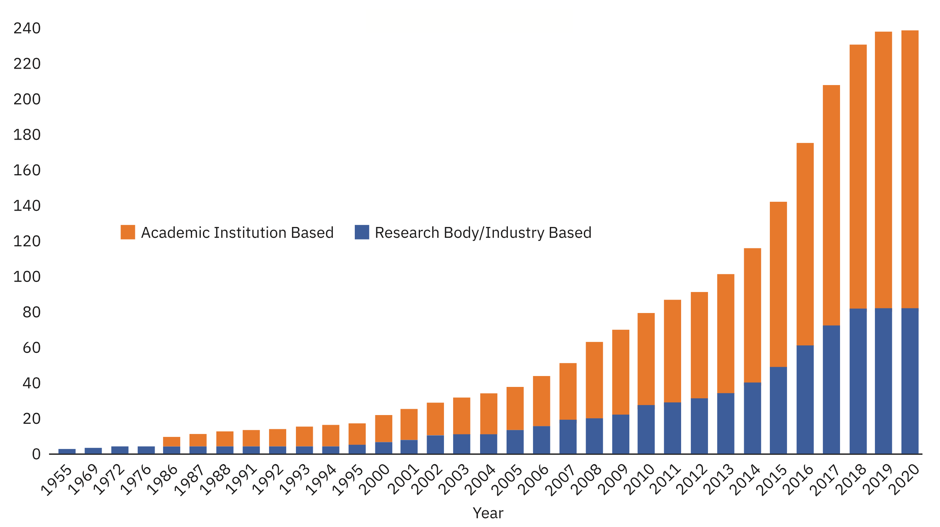The number of startup incubators in India grew 15 times over the last two decades, spurred on by vigorous incubation policy activism between 2008 and 2020.
Prolific, expansive, and promising — these are some common adjectives used to describe India’s startup ecosystem, and incubators are a prominent part and contributor to this ecosystem.
In 2017, NASSCOM found over 140 incubators in India and placed the country third in the world for the number of incubators, behind the US and China.
By October 2020, this number had multiplied. While the number of incubators is believed to be much higher, we have listed and verified over 326 incubators in India. This translates roughly to one incubator per 150 startups in India.
As the startup ecosystem is emerging from COVID-19, we pause to reflect upon the evolution of startup incubation in India over the last two decades.
Incubation can be analysed in three ways: temporal or growth of incubators and the evolution of the policy landscape over time; spatial or geographic spread of incubators; and affiliation and focus of incubators.
In this article, we focus on how incubators have grown and how the policy landscape has evolved.
Incubators’ growth and evolution of the policy landscape
Incubators are predominantly housed within academic institutions (such as IITs, IIMs, universities) or as part of industry bodies and organisations (such as NASSCOM) and research agencies (such as C-CAMP).
The steep rise in incubators — over 15 times in the last two decades — can be largely attributed to the growth in incubators affiliated with academic institutions. The jump during 2015–2019 in academic institution–based incubators could also be a result of the push from the central government towards evangelising entrepreneurship and making India “a nation of job-creators”.
The institutionalisation of incubation policies in India dates back to 1955, with the setting up of the National Small Industries Corporation (NSIC) by the Ministry of Micro, Small and Medium Enterprises.
While NSIC focussed on evangelising small businesses, technology entrepreneurship received a significant boost with the setting up of the National Science and Technology Development Board (NSTEDB) by the Department of Science and Technology (DST) in 1982.
The Incubation Policy of the MoMSME and Technology Incubation and Development of Entrepreneurs (TIDE) scheme by the Ministry of Electronics and Information Technology (MeitY) followed the setting up of NSTEDB. Both these initiatives adopted ‘commercialisation of research and technology entrepreneurship’ as the goal for incubation.

Source: Shifting Orbits: Decoding the Trajectory of the Indian Start-up Ecosystem, Universities Press (India) Private Limited
Two of the most recent incubation policy interventions — NITI Aayog’s Atal Innovation Mission (through Atal Incubation Centres) and the revised scheme from 2008, TIDE 2.0, present a somewhat novel approach to incubation.
By virtue of being the implementing body of the Startup India Initiative, AIM takes a more holistic view of entrepreneurship as against the entrepreneurship-as-technology-commercialisation stance of the older policies and schemes.
The mandates of incubators affiliated with AIM encapsulate a variety of goals, including training entrepreneurs and building startup business models.
TIDE 2.0 recognises the differences among incubators and classifies them into three levels: G1, G2, and G3, which are organised into a funnel.
G3 incubators are expected to undertake entrepreneurship evangelising activities in unexplored regions. This group primarily includes recently established incubators in academic institutions.
G2 incubation centres are expected to undertake entrepreneurship training and acceleration programmes at scale. Besides, G2 incubators are also expected to mentor G3 centres.
Finally, G1 centres are more mature incubators that are mandated with capacity building and post-investment support to startups. These centres are also expected to supervise and mentor G2 and G3 incubators.
This acknowledgement of the differences between incubators and structuring them as a system holds promise. Such a systemic view will help in the consolidation of efforts, knowledge sharing, and breaking silos between incubators, thereby unlocking significant value for the whole ecosystem.
The schemes have varied expectations from their supported incubators. The incubation schemes of MoMSME and DST underscore the commercialisation of technology for their supported incubators, while AIM’s Atal Innovation Incubators (AIC) are expected to enable startups to survive and scale by providing them with the necessary inputs.
The period between 2008 and 2020 witnessed vigorous incubation policy activism in India. During this, new policies and schemes were launched in addition to existing ones fine-tuned.
It is important to note that this was also a period of sharp growth in the number of startups founded. The growth in the number of startups between 2005 and 2008 may have created a ‘pull effect’, that is, motivated incubation policy interventions.
However, towards the late 2010s, this expanded incubation ecosystem may have, in turn, stoked the growth in new startups founded. In other words, this was a ‘push effect’ of incubators on startups.
It is important to note that the widest-reaching schemes and policies (such as those by NSTEDB, MeitY) are oriented towards technology commercialisation. While this may impel more technologies developed in labs reaching the market, it may limit other forms of starting up, such as innovative adaptation of existing technology to novel problems (blockchain for medical teleconsultation) or exploiting market asymmetries with a limited play of technology (web aggregators for insurance).
Furthermore, technology commercialisation as an objective may be more suited to incubators established within technical, science, or medical institutions. Policymakers must consider incubators in non-engineering schools and make relevant adjustments to the schemes.
Citation: "This article contains excerpts from Sharma, S, Vohra, N and Shukla, S. 2021. The Past, Present and Future of Start-up Incubation in India. In the book Shifting Orbits: Decoding the Trajectory of the Indian Start-up Ecosystem, edited by Thillai Rajan A, Srivardhini K Jha, Joffi Thomas and Rohan Chinchwadkar, 62–73. Universities Press (India) Private Limited."
Edited by Suman Singh
(Disclaimer: The views and opinions expressed in this article are those of the author and do not necessarily reflect the views of YourStory.)
Link : https://yourstory.com/2021/08/evolution-startup-incubators-incubation-policy-india
Author :- Rohan Chinchwadkar ( )
August 23, 2021 at 02:57PM
YourStory

